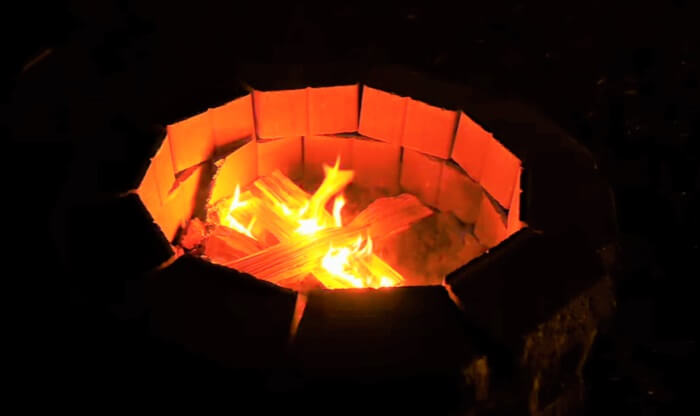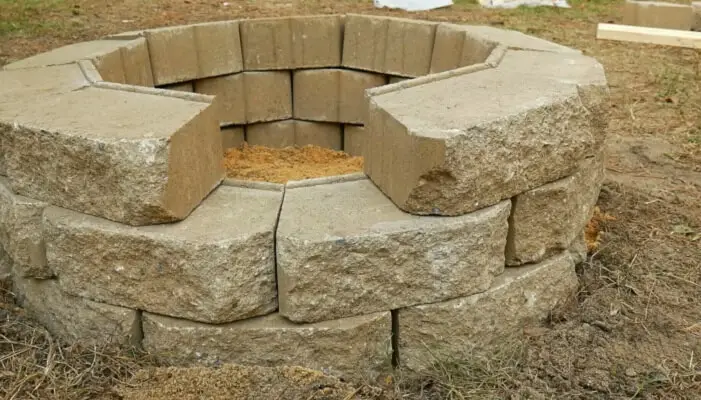Note: This article may contain affiliate links, which means if you make a purchase following our links won’t cost you extra, but we may earn a commission. Learn more
When it comes to outdoor entertaining, there’s nothing quite like gathering around a fire pit. And if you’re looking to add a fire pit to your outdoor space, you can’t go wrong with retaining wall blocks. Not only do they add a touch of style, but they’re also functional, helping to create a safe and sturdy wall around your fire pit.
When it comes to choosing retaining wall blocks, you have a few options. The most popular are interlocking blocks, which are easy to install and come in a variety of sizes, colors, and styles. Another option is mortarless blocks, which don’t require any mortar or concrete and can be stacked without any special tools.
Building a fire pit with retaining wall blocks is a great way to add value to your home. Not only will it provide you with a place to relax and entertain guests, but it will also increase the resale value of your property.
Advantages of Using Retaining Wall Blocks in Your Fire Pit
When it comes to building a fire pit, there are a lot of different options to choose from. One option that is becoming increasingly popular is using retaining wall blocks. There are a number of advantages to using retaining wall blocks for your fire pit, and in this article, we will explore some of those advantages.

One of the biggest advantages of using retaining wall blocks for your fire pit is that they can add a lot of visual appeal to your backyard. Retaining wall blocks come in a variety of colors and textures, so you can really create a unique look for your fire pit. Additionally, the blocks can be stacked in a variety of ways to create different designs.
They are very durable. Retaining wall blocks are designed to withstand a lot of wear and tear, so you don’t have to worry about them cracking or breaking over time. Because of heat resistance, so you don’t have to worry about them being damaged by the heat of the fire.
Retaining wall blocks is relatively easy to install. If you are handy with a few tools, you should be able to install the blocks yourself. However, if you are not comfortable doing it yourself, you can always hire a professional to do it for you.
Overall, there are a lot of advantages to using retaining wall blocks for your fire pit. If you are looking for a durable, easy to install, and visually appealing option, retaining wall blocks is a great choice.
How to Build a Fire Pit With Retaining Wall Blocks?
Building a fire pit with retaining wall blocks is a great way to add a focal point to your outdoor space. Here are seven steps to help you create a beautiful and functional fire pit:
Step 1: Measure and Mark the Fire Pit Area
First, you need to measure and mark the area where you want your fire pit to be. It’s important to make sure that the area is large enough for your needs but not too large that it will be overwhelming. Once you have the area measured out, use a marker or spray paint to mark the edges so you know where to build.
Step 2: Clear the Area and Remove Any Debris
Next, you need to clear the area of any debris or vegetation. This step is important to ensure that your fire pit is safe and will not catch anything on fire. Once the area is clear, you can begin to build.
Step 3: Lay the First Layer of Retaining Wall Blocks
The first layer of retaining wall blocks is the most important. This layer will provide the foundation for the rest of the fire pit. Make sure to lay the blocks in a way that they are level and even. You can use a level to make sure they are even as you go. Keep in mind that the number of blocks you’ll need will also depend on the size of the blocks themselves. Larger blocks will require fewer blocks overall, while smaller blocks will require more.

Step 4: Fill in the Gaps with Smaller Blocks or Rocks
Once the first layer is complete, you can begin to fill in the gaps with smaller blocks or rocks. This will help to make your fire pit more stable and secure. Make sure that the blocks or rocks are firmly in place before moving on to the next step.
Step 5: Add Next Layers of Retaining Wall Blocks
The second layer of retaining wall blocks will be similar to the first. Make sure that the blocks are level and even as you add them. You can use the same method as before to fill in the gaps with smaller rocks or blocks.
Step 6: Add a Layer of Sand
To help with drainage, add a layer of sand over the gravel before adding the final layer of retaining wall blocks.
Step 7: Add the Final Layer of Retaining Wall Blocks
The final layer of retaining wall blocks is the same as the others. Make sure that the blocks are level and secure. Once the final layer is complete, your fire pit is ready to use.
How Many Retaining Wall Blocks for the Fire Pit?
The size of your fire pit will determine how many retaining walls blocks you need. For a small fire pit, you will need about 12 blocks. For a medium fire pit, you will need about 18 blocks. For a large fire pit, you will need about 24 blocks.
You will also need to consider the height of your retaining wall. For a small fire pit, a retaining wall that is 12 inches tall will suffice. For a medium fire pit, a retaining wall that is 18 inches tall will work. For a large fire pit, you will need a retaining wall that is 24 inches tall.
Related: How to Make a Fire Pit Swing With a Square Fire Pit?
How to Stack Retaining Wall Blocks With Lip for a Fire Pit?
If you’re looking for a way to add a little bit of flair to your fire pit, then consider stacking retaining wall blocks with a lip. This simple addition can really make a big difference in the overall look of your fire pit. Plus, it’s a relatively easy process that anyone can do. Here’s a step-by-step guide on how to stack retaining wall blocks with a lip for a fire pit:
1. Begin by gathering the materials you’ll need. This includes retaining wall blocks, a level, a tape measure, and a hammer.
2. Next, you’ll need to determine the dimensions of your fire pit. Once you have these measurements, you can begin to assemble the retaining wall blocks.
3. Start by placing the first row of blocks around the perimeter of the fire pit. Make sure that each block is level as you go.
4. Once the first row is complete, begin stacking the second row of blocks on top. Again, make sure each block is level.
5. Continue this process until all of the retaining wall blocks are in place.

6. Finally, use the hammer to add the lip to the top of the retaining wall. This will give your fire pit a finished look.
That’s all there is to it! By following these simple steps, you can easily add a retaining wall with a lip to your fire pit. This will not only improve the appearance of your fire pit, but it will also help to contain the flames.
Do You Need Special Retaining Blocks for the Fire Pit?
There are many different ways that you can go with a fire pit. One option is to use special retaining blocks that are designed specifically for this purpose. However, you may be wondering if this is really necessary. After all, why would you need special blocks when you can just use regular ones?
There are a few reasons why you might not want to use special blocks for your fire pit. For one thing, they can be quite expensive. If you are on a budget, you may want to stick with regular blocks that are much more affordable. Additionally, special blocks can be difficult to find. If you live in an area where they are not readily available, you may have to order them online or through a specialty store.
Another reason to avoid special blocks is that they can be difficult to work with. If you are not experienced in working with stone or brick, you may find that special blocks are simply too difficult to use. In addition, if you are not careful, you could end up damaging the blocks. This would not only be a waste of money, but it could also be dangerous.
So, what should you use if you decide not to use special blocks for your fire pit? Regular blocks are perfectly fine and will work just as well. In fact, they may even be easier to work with since you will not have to worry about damaging them. Just be sure to follow the instructions carefully so that you do not end up with a mess.
Building a fire pit does not have to be complicated or expensive. With a little bit of planning and the right materials, you can create a beautiful and functional fire pit that will be the perfect addition to your backyard.
